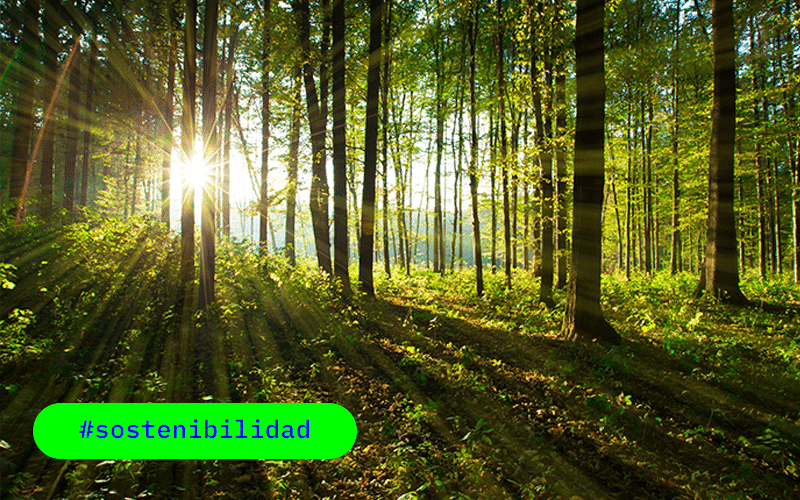Natural ecosystems, such as forests, mangroves, wetlands and oceans, act as carbon sinks by absorbing and storing CO2.
However, deforestation and degradation of these places decrease their capacity to retain carbon, affecting both their ability to absorb CO2 and biodiversity, crucial for the survival of many organisms.
What are CO2 sinks?
Carbon sinks play an important role in absorbing and storing carbon dioxide (CO2) in quantities greater than they emit. The process of capturing and storing carbon is known as carbon sequestration . This is essential to counteract CO2 levels in the atmosphere, since this gas is a powerful greenhouse agent that contributes significantly to climate change.
Carbon sequestration occurs mainly in natural ecosystems such as forests, oceans, mangroves, wetlands and other habitats. These places absorb CO2 from the atmosphere through photosynthesis and other biological processes, storing it in plant biomass, soils and sediments.
This process is crucial to counteract CO2 emissions resulting from human activities, such as the burning of fossil fuels and deforestation. By preserving and enhancing these natural carbon sinks, we can significantly contribute to mitigating climate change by reducing CO2 levels in the atmosphere and slowing its impact on global warming.
Resources that act as sinks
As we have mentioned before, there are several natural resources that act as carbon sinks and the protagonists of this are forests, soils and oceans.
- Forests: Trees absorb CO2 through photosynthesis, storing carbon in their biomass and soils.
- Oceans: Oceans absorb CO2 from the atmosphere and store it in the water column and in marine organisms, such as phytoplankton.
- Mangroves and Wetlands: These coastal ecosystems are highly efficient carbon sinks by absorbing CO2 and storing it in their soils and vegetation.
- Prairies and Grasslands : These terrestrial habitats also sequester carbon in their root and soil systems.
- Soils: Some soils have the capacity to store organic carbon, acting as carbon sinks.
- Peatlands: These are areas of humid land that can store large amounts of carbon.
- Deep marine ecosystems: Marine sediments can also act as carbon sinks by accumulating CO2.
These natural resources play a fundamental role in regulating the carbon cycle and are essential to maintain the balance of CO2 in the atmosphere. The preservation and restoration of these carbon sinks are key strategies in mitigating climate change and reducing atmospheric CO2 concentrations.
Peatlands in the Congo River Basin
The peatlands in the Congo River Basin are extensive wetlands that are formed by the accumulation of peat, an organic material composed mainly of decomposing plant remains. This process occurs in conditions of water saturation, where the lack of oxygen slows the decomposition of plant matter.
As a result, a large amount of organic carbon accumulates in these peatlands. This carbon, which would otherwise be in the atmosphere as carbon dioxide, contributing to the greenhouse effect, is stored in the soil of the peatlands and converted into biomass.
For this reason, the peatlands of the Congo Basin are considered important carbon sinks, playing a crucial role in regulating the global climate and mitigating climate change. The preservation of these peatlands is essential to maintain their capacity to store carbon and protect the unique biodiversity they host.
The Congo River basin stands out for fixing more carbon dioxide than other important forest regions such as the Amazon or Indonesia. Around 1.5 billion tons of carbon dioxide are absorbed each year in this area.
The United Nations Environment Program (UNEP) highlights the critical importance of peatlands in the fight against climate change. They show that peatlands, although they only cover about 3% of the world’s land surface, store at least twice as much carbon as all the world’s forests.
Protecting and restoring these peatlands could reduce global greenhouse gas emissions by about 800 million metric tons annually, equivalent to 3% of global emissions. UNEP even emphasizes that the conservation and restoration of peatlands is not only crucial for climate change mitigation, but also for the protection of biodiversity and the sustainability of local communities that depend on these ecosystems.
Although these ecosystems continue to capture some of the CO2 emitted, if we stopped emissions today, they could continue to gradually absorb some of that excess. However, the rate at which emissions are increasing exceeds the capacity of natural sinks to absorb all the additional CO2. Therefore, the need to reduce emissions remains critical to effectively address climate change.
Solutions to protect sinks
Essentially, protecting natural carbon sinks means caring for and strengthening existing ecosystems. This is achieved through specific actions:
Ecosystem Preservation
Stop industrial exploitation of rainforests and mangroves, as the latter are highly efficient sinks. Mangroves, in particular, serve a dual purpose by acting as trees both on land and underwater, storing carbon in both environments.
Coastal Protection
Stop the destruction of seagrass beds and prevent the drying of marshes. The recovery of these habitats is also crucial.
Peatland Conservation
Stop the exploitation of peatlands and promote their recovery. These areas are also significant in carbon absorption and storage.
Long Term Understanding
Recognize the importance of carbon sinks storing carbon for long periods. Respect natural cycles and reduce greenhouse gas emissions to maintain a balance in carbon storage.
By prioritizing the protection and restoration of these natural ecosystems, their capacity to absorb and retain CO2 can be maximized, thereby helping to counteract climate change and preserve the overall health of the planet.
Sources:
https://www.unep.org/es/noticias-y-reportajes/comunicado-de-prensa/nuevo-informe-conservar-y-restaurar-las-turberas-para
https://courier.unesco.org/es/articles/la-selva-de-la-cuenca-del-congo-un-tesoro-fragil


0 Comments